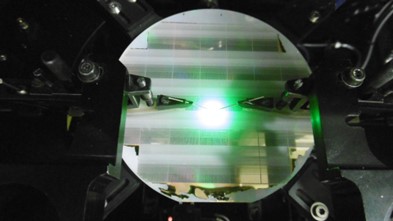◆Overview
In addition to micro-ultraviolet (UV) LEDs with a peak wavelength of 385nm, we have successfully developed three types of visible micro-LEDs with a peak wavelength of 620nm for red, 510nm for green, and 450nm for blue. In 2018 we have succeeded in high-efficiency light emission of micro UV-LEDs with a size of 12 μm x 24 μm and its peak wavelength of 385nm (patented), and have already supplied samples to many users. We have also developed visible LEDs, because many users request micro-sized chips for red, blue, and green LEDs. This time, especially for red LEDs, which are considered difficult to realize, indium gallium nitride (InGaN) is used instead of conventional materials such as gallium arsenide (GaAs) or gallium phosphide (GaP) was successful. (Green and blue minimum size are 12 μm × 24 μm.) Therefore, for the purpose of allowing users to compare the characteristics of each color, we created a micro RGB + UV
LED chips trial kit (a complete set of micro LEDs with four wavelengths: red, blue, green, and UV). We will start selling.
◆ Background
In the future, it is expected that the use of the Metaverse (virtual space) will spread not only in business but also in the home. The development of VR (virtual reality) glasses or AR (augmented reality) glasses is becoming active in various countries, such as the release of VR glasses by Google. In the future, there will be a demand for displays capable of displaying high-definition images that are smaller, lighter, and more energy efficient. Companies around the world, including Apple Inc., are competing to develop micro LED displays as the next generation of liquid crystal (LCD) and organic EL displays, but the cost and stable supply of micro LED chips have become issues. In particular, red LEDs are difficult to microchip because gallium arsenide (GaAs) and gallium phosphide (GaP) are fragile and have low light extraction efficiency due to their high refractive index. There are also challenges in achieving high efficiency. We are developing displays by exciting three types of red, blue, and green phosphors with micro UV-LEDs. Furthermore, we have succeeded in developing mass production technology for red, green, blue microchips. Therefore, users can achieve mass production of micro LED displays by mounting three types of micro LED chips of red, blue and green, which is the conventional method.
◆micro RGB + UV LED chips trial kit sales
InGaN-based LED wavelength 620nm red LED, wavelength 510nm green LED, wavelength 450nm blue LED grown on a sapphire substrate by MOCVD and 1 block of UV-LED 385nm, 4 in total is 1 set. The size of one block is 17 mm x 13 mm, and nine different sizes of microchips ranging from 12 µm x 24 µm to a maximum of 288 µm x 288 µm are placed on the sapphire substrate. (However, the minimum chip size that emits light in red is 24 μm x 48 μm or more, and the size smaller than that does not emit light.) We sell this kit so that developers of Micro LED displays can try chips with various wavelengths and sizes and select the optimum chip for mass production of Micro LED displays. For mass production, one type of chip with the optimum wavelength and size is grown on 4-inch or 6-inch sapphire substrate according to the customer's request, and then microchip processing is performed.
◆Price
1 block of red, blue, green, UV, total 4 blocks 1 set:
USD 7000.00 or JPY 1 million
◆ Data
1 block size : 17mm x 13mm
Chip shape : flip chip
Chip size : 12um x 24um, 12um x 48um, 24um x 24um, 24um x 48um,
24um x 72um, 48um x 48um, 72um x 72um, 144um x 144um, 288um x 288um Total 9 sizes
Red, green, blue, UV, micro LED chip emission spectrum data_48um x 48um chip
Red, green, blue, UV, micro LED chip I-V characteristic data_48um x 48um chip
◆Photo
Red micro LED chip light emission

Green micro LED chip light emission

Blue micro LED chip light emission
Appearance of 24μm×48μm red micro LED chip (electrode side)
|
If you would like to know more details , please contact:
|













